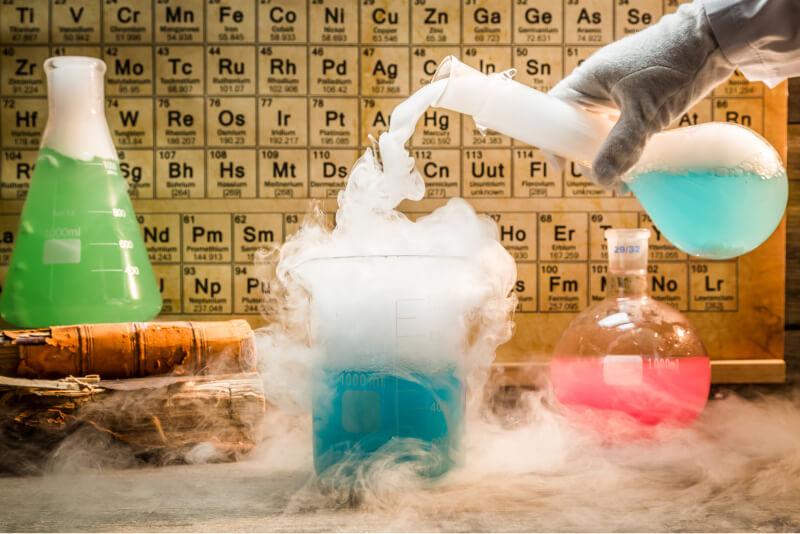Renewable Isocyanate Market Size and Share Forecast Outlook 2025 to 2035
The global renewable isocyanate market is valued at USD 38.1 million in 2025 and is set to reach USD 611.7 million by 2035, recording an absolute increase of USD 573.6 million over the forecast period. This translates into a total growth of 1,505.5%, with the market forecast to expand at a CAGR of 32.0% between 2025 and 2035. The overall market size is expected to grow by approximately 16.1X during the same period, supported by increasing demand for bio-based chemical solutions, growing adoption of environmentally responsible manufacturing processes, and rising requirements for renewable feedstock materials across polyurethane, adhesive, coating, and specialty chemical sectors.
Between 2025 and 2030, the renewable isocyanate market is projected to expand from USD 38.1 million to USD 152.6 million, resulting in a value increase of USD 114.5 million, which represents 20.0% of the total forecast growth for the decade. This phase of development will be shaped by increasing demand for alternative chemical feedstock solutions, rising regulatory pressure enabling bio-based manufacturing adoption, and growing availability of renewable raw material sourcing across polyurethane production facilities and specialty chemical operations.
Between 2030 and 2035, the market is forecast to grow from USD 152.6 million to USD 611.7 million, adding another USD 459.1 million, which constitutes 80.0% of the overall ten-year expansion. This period is expected to be characterized by the advancement of commercial-scale bio-based production technologies, the integration of circular economy principles for feedstock utilization, and the development of premium renewable isocyanate grades across diverse chemical processing applications. The growing emphasis on carbon footprint reduction and renewable content optimization will drive demand for advanced bio-based varieties with enhanced performance characteristics, improved cost competitiveness, and superior environmental profiles. Between 2020 and 2024, the renewable isocyanate market experienced emerging growth, driven by increasing regulatory focus on bio-based chemicals and growing recognition of renewable feedstock technology’s potential in delivering chemical performance equivalency across industrial and specialty applications. The market developed as chemical manufacturers recognized the potential for renewable isocyanates to deliver environmental benefits while meeting modern requirements for chemical processing operations and high-performance polymer applications. Technological advancement in bio-based production processes and feedstock conversion systems began emphasizing the critical importance of maintaining chemical functionality while enhancing production scalability and improving cost-effectiveness across diverse industrial sectors.
From 2030 to 2035, the market is forecast to grow from USD 152.6 million to USD 611.7 million, adding another USD 459.1 million, which constitutes 80.0% of the overall ten-year expansion. This period is expected to be characterized by the advancement of integrated bio-refinery systems, the integration of advanced purification technologies for enhanced product quality, and the development of specialized renewable isocyanate formulations for enhanced polymerization characteristics. The growing emphasis on production efficiency and chemical performance optimization will drive demand for premium varieties with enhanced reactivity profiles, improved processing compatibility, and superior functionality characteristics.
Between 2020 and 2024, the renewable isocyanate market experienced accelerating growth, driven by increasing awareness of bio-based chemical benefits and growing recognition of renewable production systems’ effectiveness in supporting efficient chemical manufacturing operations across polymer production facilities and specialty chemical services. The market developed as users recognized the potential for renewable isocyanates to deliver performance advantages while meeting modern requirements for environmental compliance and reliable chemical functionality. Technological advancement in bio-feedstock processing methods and quality optimization systems began emphasizing the critical importance of maintaining chemical specifications while extending production capabilities and improving customer acceptance across diverse polyurethane applications.
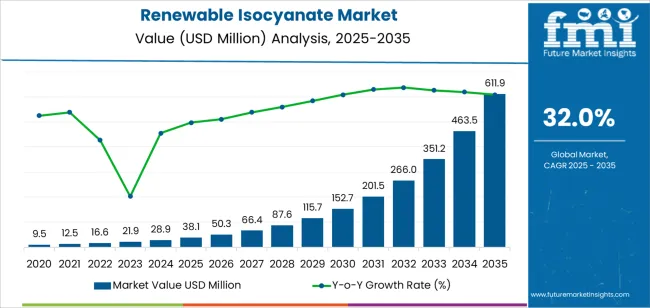
Quick Stats for Renewable Isocyanate Market
Renewable Isocyanate Market Value (2025): USD 38.1 million
Renewable Isocyanate Market Forecast Value (2035): USD 611.7 million
Renewable Isocyanate Market Forecast CAGR: 32.0%
Leading Product Category in Renewable Isocyanate Market: Bio-based Methylene Diphenyl Diisocyanate (MDI) (42.3%)
Key Growth Regions in Renewable Isocyanate Market: Asia Pacific, North America, Europe
Key Players in Renewable Isocyanate Market: BASF, Covestro, Mitsui Chemicals, Wanhua Chemical, Gansu Yinguang Chemical
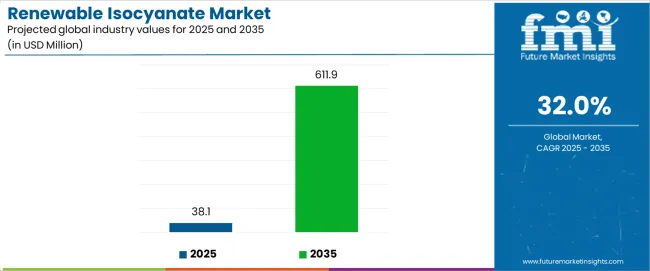
Renewable Isocyanate Market Key Takeaways
Metric
Value
Estimated Value in (2025E)
USD 38.1 million
Forecast Value in (2035F)
USD 611.7 million
Forecast CAGR (2025 to 2035)
32.0%
Why is the Renewable Isocyanate Market Growing?
Market expansion is being supported by the increasing global demand for bio-based chemical solutions and the corresponding shift toward renewable feedstock materials that can provide superior environmental characteristics while meeting user requirements for chemical performance and cost-effective production processes. Modern chemical manufacturers are increasingly focused on incorporating renewable isocyanate systems that can enhance product positioning while satisfying demands for reduced carbon intensity, precisely controlled chemical functionality, and optimized raw material sourcing practices. Renewable isocyanates’ proven ability to deliver chemical performance, environmental benefits, and diverse application possibilities makes them essential components for forward-thinking chemical companies and environmentally conscious polymer manufacturers.
The growing emphasis on circular economy principles and carbon footprint reduction is driving demand for high-performance renewable chemical systems that can support distinctive polymer outcomes and comprehensive environmental benefits across polyurethane foam production, coating formulations, and specialty adhesive applications. User preference for chemicals that combine functional excellence with environmental responsibility is creating opportunities for innovative implementations in both traditional and emerging chemical applications. The rising influence of regulatory frameworks promoting bio-based chemicals and advanced production technologies is also contributing to increased adoption of renewable isocyanates that can provide authentic performance benefits and reliable environmental characteristics.
Segmental Analysis
The market is segmented by product type, application, feedstock source, production technology, end-use industry, and region. By product type, the market is divided into bio-based methylene diphenyl diisocyanate (MDI), bio-based toluene diisocyanate (TDI), bio-based aliphatic isocyanate, bio-based specialty isocyanates, and others. Based on application, the market is categorized into rigid foam production, flexible foam manufacturing, paints and coatings formulation, adhesives and sealants production, elastomers manufacturing, and others. By feedstock source, the market includes plant-based oils, agricultural residues, waste biomass, and recycled carbon sources. By production technology, the market encompasses bio-catalytic processes, fermentation-based methods, chemical conversion technologies, and hybrid production systems. By end-use industry, the market is divided into construction materials, automotive components, furniture manufacturing, packaging solutions, and industrial applications. Regionally, the market is divided into North America, Europe, Asia Pacific, Latin America, Middle East & Africa, and other regions.
By Product Type, the Bio-based Methylene Diphenyl Diisocyanate (MDI) Segment Accounts for 42.3% Market Share
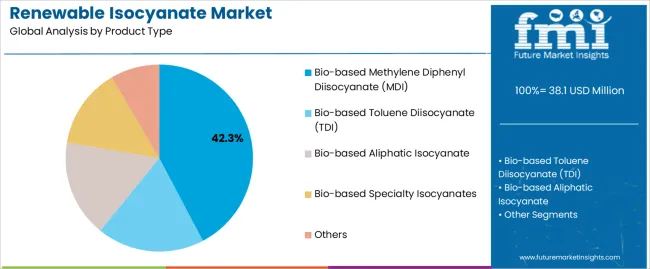
The bio-based methylene diphenyl diisocyanate (MDI) segment is projected to account for 42.3% of the renewable isocyanate market in 2025, reaffirming its position as the leading product category. Chemical manufacturers and polyurethane producers increasingly utilize bio-based MDI for its superior performance characteristics, established chemical functionality, and essential properties in diverse polymer applications across multiple industrial sectors. Bio-based MDI’s proven chemical performance and established cost-effectiveness directly address user requirements for reliable polymerization processes and optimal polymer properties in commercial applications.
This product segment forms the foundation of modern renewable chemical production patterns, as it represents the chemical category with the greatest market acceptance potential and established compatibility across multiple polyurethane systems. Industry investments in bio-based production technology and performance optimization continue to strengthen adoption among quality-conscious manufacturers. With users prioritizing chemical consistency and environmental benefits, bio-based MDI aligns with both performance objectives and environmental requirements, making it the central component of comprehensive renewable chemical strategies.
By Application, Rigid Foam Production Segment Shows Strong Market Dominance
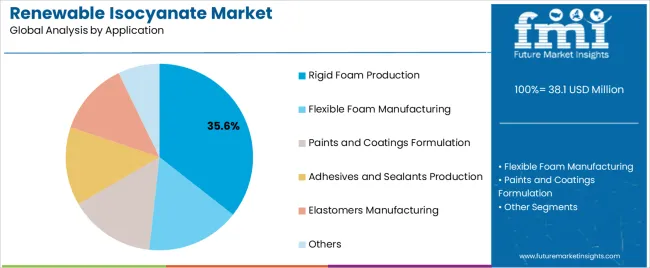
Rigid foam production is projected to represent 35.6% of the renewable isocyanate market in 2025, underscoring its critical role as the primary application for performance-focused manufacturers seeking superior polymer efficiency benefits and enhanced product environmental credentials. Polyurethane producers and foam manufacturers prefer rigid foam applications for their established market volumes, proven performance demand, and ability to maintain exceptional structural properties while supporting versatile insulation requirements during diverse construction projects. Positioned as essential applications for environmentally conscious manufacturers, rigid foam offerings provide both performance excellence and environmental positioning advantages.
The segment is supported by continuous improvement in foam technology and the widespread availability of established performance standards that enable quality assurance and premium positioning at the manufacturer level. The foam companies are optimizing isocyanate selections to support product differentiation and competitive environmental strategies. As polymer technology continues to advance and manufacturers seek efficient bio-based materials, rigid foam applications will continue to drive market growth while supporting business development and environmental compliance strategies.
What are the Drivers, Restraints, and Key Trends of the Renewable Isocyanate Market?
The market is advancing rapidly due to increasing environmental consciousness and growing need for bio-based chemical solutions that emphasize superior environmental outcomes across polymer segments and industrial applications. The market faces challenges, including competition from conventional isocyanate technologies, production scale limitations, and feedstock cost pressures affecting operational economics. Innovation in bio-production integration and advanced feedstock utilization continues to influence market development and expansion patterns.
Expansion of Bio-based Chemical Applications
The growing adoption of renewable isocyanates in polymer production and chemical manufacturing is enabling companies to develop chemical strategies that provide distinctive environmental benefits while commanding premium positioning and enhanced product environmental characteristics. Bio-based applications provide superior environmental profiles while allowing more sophisticated performance features across various polymer categories. Users are increasingly recognizing the operational advantages of renewable positioning for premium chemical outcomes and environmentally conscious product integration.
Integration of Circular Economy and Advanced Bio-production Systems
Modern renewable isocyanate manufacturers are incorporating advanced bio-refinery technologies, circular feedstock utilization systems, and automated quality monitoring to enhance production efficiency, improve environmental benefits, and meet commercial demands for reliable bio-based chemical solutions. These systems improve operational effectiveness while enabling new applications, including waste-to-chemical programs and integrated bio-production protocols. Advanced circular economy integration also allows manufacturers to support environmental leadership positioning and carbon reduction beyond traditional chemical operations.
Analysis of the Renewable Isocyanate Market by Key Country
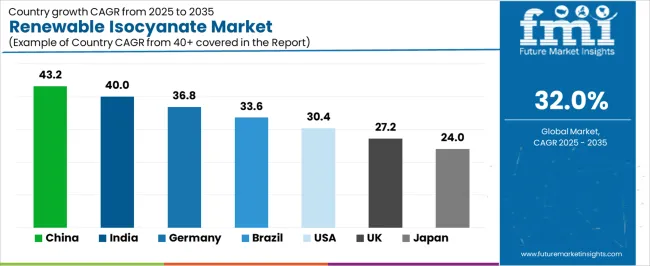
Country
CAGR (2025 to 2035)
China
43.2%
India
40.0%
Germany
36.8%
Brazil
33.6%
USA
30.4%
UK
27.2%
Japan
24.0%
The renewable isocyanate market is experiencing exceptional growth globally, with China leading at a 43.2% CAGR through 2035, driven by the expanding chemical manufacturing sector, growing bio-based chemical requirements, and increasing adoption of renewable production systems. India follows at 40.0%, supported by rising chemical industry development, expanding polymer manufacturing sector, and growing acceptance of environmentally responsible chemical solutions. Germany shows growth at 36.8%, emphasizing established chemical manufacturing capabilities and comprehensive bio-based technology development. Brazil records 33.6%, focusing on bio-feedstock availability and chemical industry expansion. The USA demonstrates 30.4% growth, prioritizing advanced bio-chemical technologies and production optimization.
The report covers an in-depth analysis of 40+ countries, top-performing countries are highlighted below.
China Leads Global Market Growth with Chemical Industry Expansion
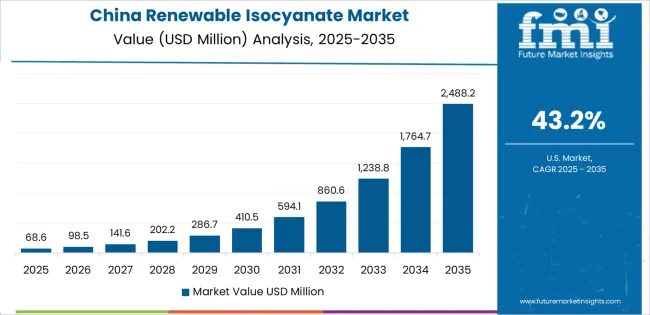
The demand for renewable isocyanate consumption and production in China is projected to exhibit exceptional growth with a CAGR of 43.2% through 2035, driven by the country’s rapidly expanding chemical manufacturing sector, favorable government policies toward bio-based chemical development, and initiatives promoting renewable production technologies across major industrial regions. China’s position as a leading chemical manufacturing hub and increasing focus on environmental compliance are creating substantial demand for high-quality renewable isocyanates in both domestic and export markets. Major chemical companies and polymer manufacturers are establishing comprehensive bio-based production capabilities to serve growing demand and emerging market opportunities.
Established chemical manufacturing culture and expanding bio-based production practices are driving demand for renewable isocyanates across commercial projects, industrial facilities, and comprehensive polymer systems throughout Chinese chemical markets.
Strong manufacturing infrastructure and environmental policy initiatives are supporting the rapid adoption of premium renewable isocyanates among quality-conscious manufacturers seeking to meet evolving environmental standards and performance requirements.
India Demonstrates Strong Market Potential with Chemical Industry Focus
The demand for renewable isocyanate products in India is expanding at a CAGR of 40.0%, supported by rising chemical industry investment, growing polymer development, and expanding manufacturing capabilities. The country’s developing chemical sector and increasing commercial investment in bio-based technologies are driving demand for renewable isocyanates across both traditional and modern polymer applications. International chemical companies and domestic producers are establishing comprehensive operational networks to address growing market demand for renewable chemicals and efficient bio-based solutions.
Rising chemical industry investment and expanding polymer activity are creating opportunities for renewable isocyanate adoption across manufacturing operations, modern chemical projects, and production companies throughout major Indian industrial regions.
Growing bio-based chemical development initiatives and production technology advancement are driving the adoption of renewable products and services among domestic manufacturers seeking to enhance their operational capabilities and meet increasing environmental demand.
Germany Maintains Market Leadership with Technical Excellence
The renewable isocyanate market in Germany is projected to grow at a CAGR of 36.8% through 2035, supported by the country’s mature chemical manufacturing sector, established environmental standards, and leadership in bio-based technology. Germany’s sophisticated chemical infrastructure and strong support for renewable production systems are creating steady demand for both traditional and innovative bio-based varieties. Leading chemical manufacturers and specialty producers are establishing comprehensive operational strategies to serve both domestic markets and growing export opportunities.
Advanced chemical manufacturing capabilities and established industrial markets are driving demand for premium renewable isocyanates across automotive facilities, specialty manufacturers, and comprehensive chemical companies seeking superior environmental profiles and technical innovation.
Strong environmental excellence culture and commercial leadership are supporting the adoption of innovative bio-based chemicals among users prioritizing production efficiency and environmental compliance in polymer applications.
Brazil Strengthens Position with Bio-feedstock Advantages
Revenue from renewable isocyanate products in Brazil is projected to grow at a CAGR of 33.6% through 2035, driven by the country’s emphasis on bio-feedstock availability, chemical industry development, and growing polymer manufacturing capabilities. Brazilian chemical companies and manufacturers consistently seek bio-based chemicals that enhance environmental performance and support operational excellence for both traditional and modern polymer applications. The country’s position as a bio-feedstock leader continues to drive innovation in renewable chemical applications and commercial production standards.
Expanding bio-feedstock culture and growing chemical markets are driving demand for commercial renewable isocyanates across polymer manufacturers, chemical providers, and production-focused outlets seeking superior environmental performance and distinctive chemical profiles.
Increasing focus on environmental compliance and commercial bio-based systems is supporting the adoption of renewable chemical varieties among manufacturers and distributors seeking authentic Brazilian bio-based products in regional markets with established environmental expertise.
USA Anchors Growth with Technology Integration
Revenue from renewable isocyanate products in the USA is projected to grow at a CAGR of 30.4% through 2035, supported by the country’s emphasis on chemical technology advancement, production optimization, and advanced environmental integration requiring efficient bio-based solutions. American manufacturers and chemical users prioritize performance reliability and environmental compliance, making renewable isocyanates essential components for both traditional and modern polymer applications. The country’s comprehensive technology leadership and advancing chemical patterns support continued market expansion.
Advanced technology capabilities and growing environmental compliance are driving demand for renewable isocyanates across specialty applications, modern industrial formats, and technology-integrated chemical programs serving domestic markets with increasing environmental requirements.
Strong focus on production optimization and environmental excellence is encouraging manufacturers and distributors to adopt bio-based solutions that support environmental objectives and meet American quality standards for polymer applications.
UK Maintains Steady Growth with Environmental Focus
Revenue from renewable isocyanate products in the UK is projected to grow at a CAGR of 27.2% through 2035, supported by established environmental standards, mature chemical markets, and emphasis on production efficiency across commercial and industrial sectors. British manufacturers and chemical professionals prioritize environmental performance and operational consistency, creating steady demand for premium bio-based solutions. The country’s comprehensive market maturity and established chemical practices support continued development in renewable applications.
Established chemical markets and mature polymer industry are driving demand for quality renewable isocyanates across commercial projects, manufacturing operations, and professional chemical companies throughout British industrial regions.
Strong emphasis on environmental standards and operational reliability is supporting the adoption of premium bio-based varieties among manufacturers seeking proven performance and established environmental credentials in polymer applications.
Japan Demonstrates Precision-Focused Growth
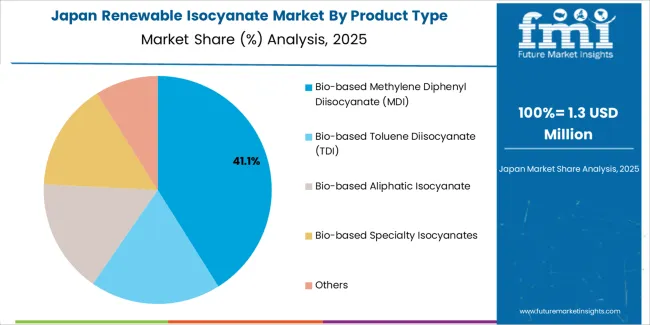
Revenue from renewable isocyanate products in Japan is projected to grow at a CAGR of 24.0% through 2035, supported by the country’s emphasis on precision manufacturing, quality excellence, and advanced technology integration requiring efficient bio-based solutions. Japanese businesses and chemical users prioritize technical performance and environmental precision, making renewable isocyanates essential components for both traditional and modern polymer applications. The country’s comprehensive quality leadership and advancing chemical patterns support continued market expansion.
Advanced chemical technology capabilities and growing precision polymer applications are driving demand for renewable isocyanates across specialty chemical applications, modern production formats, and technology-integrated manufacturing programs serving domestic markets with increasing quality requirements.
Strong focus on technical precision and environmental excellence is encouraging businesses and distributors to adopt bio-based solutions that support quality objectives and meet Japanese precision standards for polymer applications.
Europe Market Split by Country
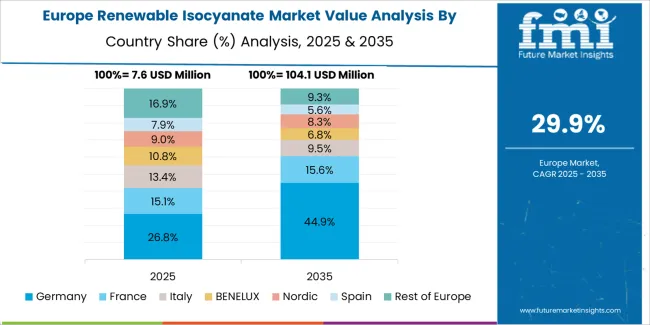
The Europe renewable isocyanate market is projected to grow from USD 12.5 million in 2025 to USD 201.5 million by 2035, recording a CAGR of 32.5% over the forecast period. Germany leads the region with a 38.2% share in 2025, moderating slightly to 37.8% by 2035, supported by its strong chemical manufacturing base and demand for premium, environmentally advanced bio-based chemical solutions. The United Kingdom follows with 22.1% in 2025, easing to 21.7% by 2035, driven by mature chemical markets and emphasis on environmental compliance and production optimization. France accounts for 15.8% in 2025, rising to 16.3% by 2035, reflecting steady adoption of bio-based chemical solutions and operational efficiency enhancement. Italy holds 11.6% in 2025, expanding to 12.2% by 2035 as chemical manufacturing and specialty polymer applications grow. Spain contributes 6.9% in 2025, growing to 7.3% by 2035, supported by expanding chemical sector and production modernization. The Nordic countries rise from 3.8% in 2025 to 4.1% by 2035 on the back of strong environmental technology adoption and advanced chemical methodologies. BENELUX remains at 1.6% share across both 2025 and 2035, reflecting mature, environmentally focused chemical markets.
Competitive Landscape of the Renewable Isocyanate Market
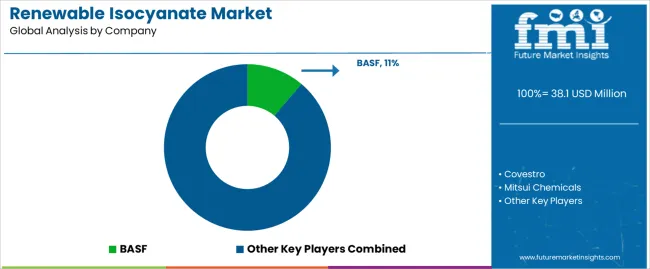
The renewable isocyanate market is characterized by competition among established chemical manufacturers, specialized bio-based producers, and integrated polymer solution companies. Companies are investing in bio-production technologies, advanced feedstock development systems, product innovation capabilities, and comprehensive distribution networks to deliver consistent, high-quality, and reliable renewable isocyanate systems. Innovation in environmental performance enhancement, production scalability optimization, and application-specific product development is central to strengthening market position and customer satisfaction.
BASF leads the market with a strong focus on chemical innovation and comprehensive renewable isocyanate solutions, offering commercial bio-based chemical systems with emphasis on manufacturing excellence and environmental heritage. Covestro provides specialized polymer chemicals with a focus on industrial market applications and performance engineering networks. Mitsui Chemicals delivers integrated chemical solutions with a focus on manufacturer positioning and operational efficiency. Wanhua Chemical specializes in comprehensive isocyanate production with an emphasis on cost-effective applications. Gansu Yinguang Chemical focuses on comprehensive industrial chemical production with advanced manufacturing and competitive positioning capabilities.
Global Renewable Isocyanate Market – Stakeholder Contribution Framework
The success of renewable isocyanates in meeting commercial chemical demands, manufacturer-driven environmental requirements, and performance integration will not only enhance polymer quality outcomes but also strengthen global bio-based chemical manufacturing capabilities. It will consolidate emerging regions’ positions as hubs for efficient renewable chemical production and align advanced economies with environmental chemical systems. This calls for a concerted effort by all stakeholders — governments, industry bodies, manufacturers, distributors, and investors. Each can be a crucial enabler in preparing the market for its next phase of growth.
How Governments Could Spur Local Production and Adoption?
Targeted Incentives: Introduce bio-based manufacturing subsidies for companies adopting advanced renewable isocyanate production technologies in chemical manufacturing and polymer regions, and production-linked incentives for facilities producing bio-based chemicals for domestic consumption and export markets.
Trade Agreements: Accelerate export growth through bilateral and multilateral agreements that classify renewable isocyanates under “bio-based specialty chemicals,” easing cross-border regulatory approvals and technical certifications.
Facilitate Innovation: Establish Centers of Excellence for bio-based chemical innovation and renewable production engineering. Fund R&D into efficient bio-production systems, feedstock optimization, and quality-standard integration for commercial polymer operations.
How Industry Bodies Could Support Market Development?
Foster Connectivity: Constitute a global renewable isocyanate consortium linking bio-based manufacturers, chemical suppliers, polymer producers, and policymakers to align production targets with environmental and performance commitments.
Promote Exports: Work with export councils to brand renewable isocyanates as premium, environmentally engineered chemical solutions. Facilitate trade fairs to connect bio-chemical innovators with global buyers in construction, automotive, and polymer sectors.
Upskilling Programs: Develop curricula on advanced bio-production manufacturing, feedstock selection, quality control processes, and environmental optimization to prepare manufacturers and operators for premium market opportunities.
How Distributors and Chemical Industry Players Could Strengthen the Ecosystem?
Drive Integration: Bundle renewable isocyanates with environmental-focused marketing and efficiency messaging systems. Position bio-based chemicals as part of holistic “environmental optimization solutions.”
Forge Partnerships: Collaborate with chemical manufacturers and technology providers for joint R&D on bio-based applications, environmental enhancement initiatives, and global quality assurance for premium markets.
How Manufacturers Could Navigate the Shift?
Capture Premium Markets: Leverage government incentives and rising environmental demand to offer renewable isocyanates into growth markets where conventional chemicals face environmental and regulatory challenges.
Invest in Technology: Partner with technology providers to advance efficient bio-production workflows, commercial-grade quality, and advanced manufacturing practices.
Build Capabilities: Train technical staff and environmental specialists to demonstrate renewable isocyanates’ environmental advantages, repositioning commercial relationships toward long-term supply partnerships.
Key Players in the Renewable Isocyanate Market
BASF
Covestro
Mitsui Chemicals
Wanhua Chemical
Gansu Yinguang Chemical (Norinco Group)
Huntsman Corporation
Dow Chemical Company
Tosoh Corporation
Vencorex
LANXESS
Sadara Chemical Company
Kumho Mitsui Chemicals
BorsodChem
OCI Corporation
MCNS
Scope of the Report
Items
Values
Quantitative Units (2025)
USD 38.1 million
Product Type
Bio-based Methylene Diphenyl Diisocyanate (MDI), Bio-based Toluene Diisocyanate (TDI), Bio-based Aliphatic Isocyanate, Bio-based Specialty Isocyanates, Others
Application
Rigid Foam Production, Flexible Foam Manufacturing, Paints and Coatings Formulation, Adhesives and Sealants Production, Elastomers Manufacturing, Others
Feedstock Source
Plant-based Oils, Agricultural Residues, Waste Biomass, Recycled Carbon Sources
Production Technology
Bio-catalytic Processes, Fermentation-based Methods, Chemical Conversion Technologies, Hybrid Production Systems
End-use Industry
Construction Materials, Automotive Components, Furniture Manufacturing, Packaging Solutions, Industrial Applications
Regions Covered
North America, Europe, Asia Pacific, Latin America, Middle East & Africa, Other Regions
Countries Covered
China, India, Germany, Brazil, United States, United Kingdom, Japan, and 40+ countries
Key Companies Profiled
BASF, Covestro , Mitsui Chemicals, Wanhua Chemical, Gansu Yinguang Chemical, and other leading renewable isocyanate companies
Additional Attributes
Dollar sales by product type, application, feedstock source, production technology, end-use industry, and region; regional demand trends, competitive landscape, technological advancements in bio-production engineering, feedstock optimization initiatives, environmental enhancement programs, and premium bio-based product development strategies
Renewable Isocyanate Market by Segments By Product Type:
Bio-based Methylene Diphenyl Diisocyanate (MDI)
Bio-based Toluene Diisocyanate (TDI)
Bio-based Aliphatic Isocyanate
Bio-based Specialty Isocyanates
Others
By Application:
Rigid Foam Production
Flexible Foam Manufacturing
Paints and Coatings Formulation
Adhesives and Sealants Production
Elastomers Manufacturing
Others
By Feedstock Source:
Plant-based Oils
Agricultural Residues
Waste Biomass
Recycled Carbon Sources
By Production Technology:
Bio-catalytic Processes
Fermentation-based Methods
Chemical Conversion Technologies
Hybrid Production Systems
By End-use Industry:
Construction Materials
Automotive Components
Furniture Manufacturing
Packaging Solutions
Industrial Applications
By Region:
North America
United States
Canada
Mexico
Europe
Germany
United Kingdom
France
Italy
Spain
Nordic Countries
BENELUX
Rest of Europe
Asia Pacific
China
India
Japan
South Korea
Australia
Rest of Asia Pacific
Latin America
Brazil
Argentina
Rest of Latin America
Middle East & Africa
Kingdom of Saudi Arabia
United Arab Emirates
South Africa
Rest of Middle East & Africa
Other Regions
Oceania
Central Asia
Other Markets
Frequently Asked Questions
How big is the renewable isocyanate market in 2025?
The global renewable isocyanate market is estimated to be valued at USD 38.1 million in 2025.
What will be the size of renewable isocyanate market in 2035?
The market size for the renewable isocyanate market is projected to reach USD 611.9 million by 2035.
How much will be the renewable isocyanate market growth between 2025 and 2035?
The renewable isocyanate market is expected to grow at a 32.0% CAGR between 2025 and 2035.
What are the key product types in the renewable isocyanate market?
The key product types in renewable isocyanate market are bIO-based methylene diphenyl diisocyanate (mdi), bIO-based toluene diisocyanate (tdi), bIO-based aliphatic isocyanate, bIO-based specialty isocyanates and others.
Which application segment to contribute significant share in the renewable isocyanate market in 2025?
In terms of application, rigid foam production segment to command 35.6% share in the renewable isocyanate market in 2025.

